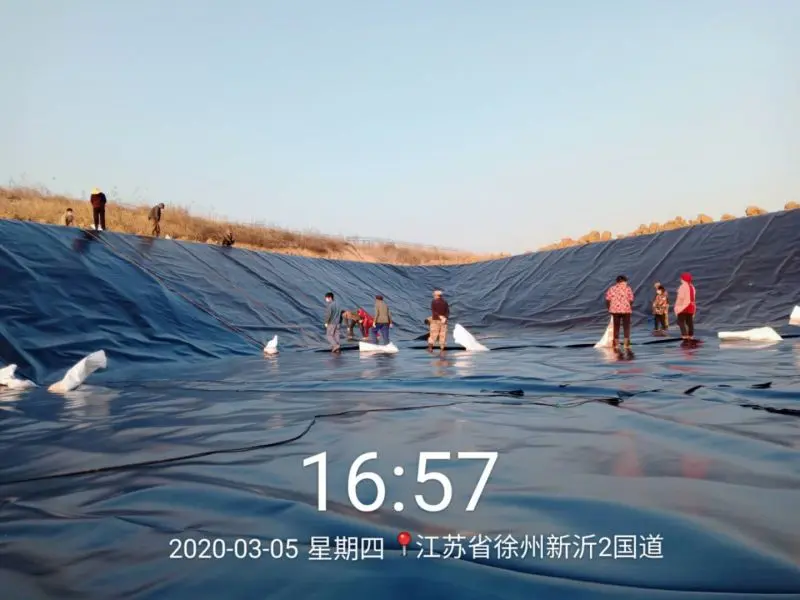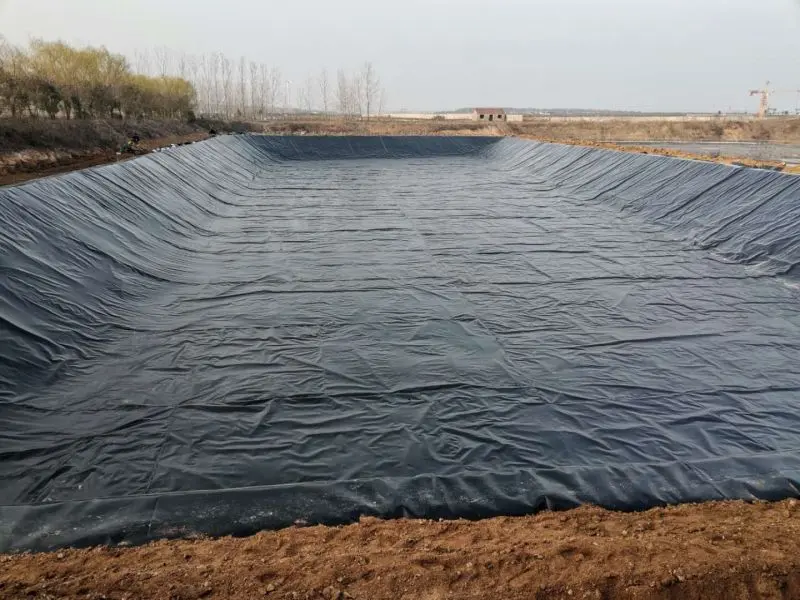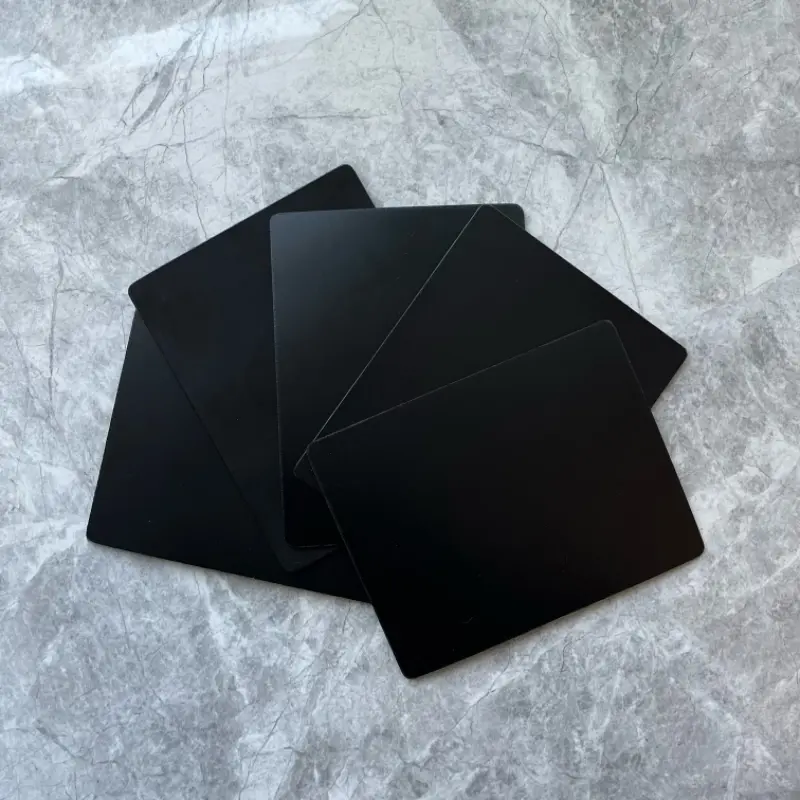What is hdpe geomembrane?

Geotextile membrane possesses excellent impermeability, elasticity, and deformation adaptability, making it suitable for various construction conditions and working stresses. Therefore, it is a lightweight, easy-to-install, cost-effective, and reliable impermeable material widely used in dam and flood control projects. There are various types of geotextile membranes available for use, including LDPE (Low-Density Polyethylene) and HDPE (High-Density Polyethylene) geotextile membranes. While they share similarities, there are also some differences between them.
Product properties of hdpe geomembrane
HDPE geomembranes have several key properties that make them suitable for a range of applications:
1, Impermeability: HDPE geomembranes exhibit excellent impermeability, preventing the passage of liquids and gases. This property is crucial for containment applications such as landfill liners, reservoirs, and chemical storage facilities.
2, Chemical Resistance: HDPE geomembranes are highly resistant to a wide range of chemicals, including acids, alkalis, and organic solvents. This resistance makes them ideal for use in applications involving hazardous substances, such as industrial waste containment.
3, UV Resistance: HDPE geomembranes are UV stabilized, meaning they can withstand prolonged exposure to sunlight without significant degradation. This property is important for applications such as exposed liners in ponds or reservoirs.
4, Flexibility: HDPE geomembranes are flexible and conformable to uneven surfaces, making them easy to install and suitable for lining applications with irregular geometries.
5, Tear and Puncture Resistance: HDPE geomembranes have high tensile strength and resistance to puncture and tearing, ensuring long-term integrity in demanding environmental conditions.
Applications of hdpe geomembrane

HDPE geomembranes find applications in various industries and projects, including:
1, Landfills: Used as liners and caps in landfill construction to prevent the migration of leachate into the surrounding environment and groundwater contamination.
2, Pond and Reservoir Liners: Employed to create impermeable barriers in ponds, reservoirs, and retention basins for water containment and environmental protection.
3, Mining: Used for heap leach pads, tailings dams, and wastewater containment in mining operations to prevent environmental contamination from mine waste.
4, Agriculture: Utilized in irrigation reservoirs, wastewater lagoons, and silage storage facilities to contain water and agricultural chemicals, protecting soil and water resources.
5, Aquaculture: Employed in fish ponds and aquaculture facilities to create watertight barriers and prevent seepage.
6, Civil Engineering: Used in canal and irrigation channel lining, stormwater management systems, and erosion control applications to manage water resources and prevent soil erosion.
Overall, HDPE geomembranes offer a versatile solution for a wide range of containment and environmental protection needs in various industries.
What is LDPE geomembrane

LDPE geomembrane refers to Low-Density Polyethylene geomembrane. Like HDPE geomembranes, LDPE geomembranes are synthetic liners used in geotechnical and environmental engineering projects. Here are some of their key properties and applications:
Product Properties of LDPE geomembrane
1, Flexibility: LDPE geomembranes are known for their high flexibility, allowing them to conform to irregular surfaces and accommodate settlement or movement in the substrate.
2, Sealing Properties: They offer good sealing properties due to their ability to fuse together with heat, creating strong seams that prevent leaks.
3, Chemical Resistance: LDPE geomembranes provide moderate resistance to chemicals, making them suitable for applications where exposure to certain substances is expected.
4, Puncture Resistance: While not as high as HDPE geomembranes, LDPE geomembranes still offer decent puncture resistance, protecting against damage during installation and use.
5, UV Stability: LDPE geomembranes typically have lower UV resistance compared to HDPE geomembranes, so they are often used in covered applications or environments with minimal exposure to sunlight.
Applications of LDPE geomembrane
1, Decorative Ponds and Landscaping: LDPE geomembranes are commonly used in decorative ponds and landscaping projects to create watertight barriers and prevent seepage.
2, Canal and Irrigation Liners: They are used in canal and irrigation channel lining to prevent water seepage and loss, ensuring efficient water distribution in agricultural areas.
3, Secondary Containment: LDPE geomembranes are used in secondary containment systems for chemical storage tanks, protecting against leaks and spills that could harm the environment.
4, Waste Containment: They are used in smaller-scale waste containment applications such as residential septic systems, pond liners, and small landfills.
5, Floating Covers: LDPE geomembranes are sometimes used as floating covers for reservoirs or wastewater treatment ponds to prevent evaporation and contamination.
LDPE geomembranes are suitable for applications where moderate chemical resistance and flexibility are required, making them a cost-effective option for certain containment and lining projects. However, their lower puncture resistance and UV stability compared to HDPE geomembranes may limit their suitability in certain environments.
The comparison between Hdpe geomembrane and Ldpe geomembrane

LDPE geomembranes and HDPE geomembranes are two common types of plastic films used for protection and support structures. They share many similar functions and characteristics, but also have some differences. Here's a detailed comparison of their similarities and differences.
The similarities between Hdpe geomembrane and Ldpe geomembrane
1, Material Characteristics: LDPE geomembranes and HDPE geomembranes are both plastic films with high transparency and abrasion resistance. They have good tensile strength and elongation at break.
2, Applications: Both types of geomembranes are widely used for protection and support structures, such as in coastal areas, riversides, groundwater filtration, and in building structures.
3, Physical Properties: LDPE geomembranes and HDPE geomembranes both exhibit good chemical corrosion resistance, wear resistance, and weather resistance.
The differences betweenHdpe geomembrane and Ldpe geomembrane
1, Transparency: HDPE geomembranes have higher transparency, making it easier to observe the internal conditions of materials, while the transparency of LDPE geomembranes is relatively lower.
2, Aging Resistance: LDPE geomembranes are more durable and less susceptible to the effects of UV, chemical, and physical factors compared to HDPE geomembranes.
3, Tensile Strength: HDPE geomembranes have higher tensile strength, able to withstand greater stress, while LDPE geomembranes have relatively lower tensile strength.
4, Chemical Stability: LDPE geomembranes have better chemical stability, compatible with a wider range of chemicals compared to HDPE geomembranes.
5, Due to the outstanding performance of HDPE geomembranes and LDPE geomembranes, their prices are significantly higher than LDPE geomembranes. When purchasing, companies will choose based on their own needs and the differences in requirements.
In conclusion, although these two types of geomembranes share many similarities, they also have some differences in physical properties, transparency, aging resistance, tensile strength, and chemical stability.
If you are interested in this kind of products, fell free to contact me:
Echo: 0086-18853127527 phone/whatsapp
Email: export@hygeosynthetics.com

897.webp)
942.webp)
237.webp)